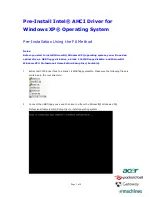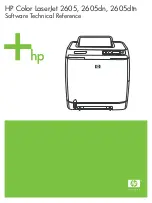
2
Chapter 1. Steps to Get You Started
1.2. Is Your Hardware Compatible?
Hardware compatibility is particularly important if you have an older system or a system that you built
yourself. Red Hat Enterprise Linux ES 2.1 should be compatible with most hardware in systems that
were factory built within the last two years. However, hardware specifications change almost daily, so
it is hard to guarantee that your hardware will be 100% compatible.
The most recent list of supported hardware can be found at http://hardware.redhat.com/hcl/.
1.3. Do You Have Enough Disk Space?
Nearly every modern-day operating system (OS) uses
disk partitions
, and Red Hat Enterprise Linux
ES is no exception. When you install Red Hat Enterprise Linux ES, you may have to work with disk
partitions. If you have not worked with disk partitions before (or need a quick review of the basic
concepts) read Appendix D before proceeding.
The disk space used by Red Hat Enterprise Linux ES must be separate from the disk space used by
other OSes you might have installed on your system , such as Windows, OS/2, or even a different
version of Linux. At least two partitions (
/
and
swap
) must be dedicated to Red Hat Enterprise Linux
ES.
Before you start the installation process, one of the following conditions must be met:
•
Your computer must have enough
unpartitioned
1
disk space for the installation of Red Hat Enter-
prise Linux ES.
•
You must have one or more partitions that may be deleted, thereby freeing up enough disk space to
install Red Hat Enterprise Linux ES.
1.3.1. Installation Disk Space Requirements
Note
These recommendations are based on an installation that only installs one language (such as En-
glish). If you plan to install multiple languages to use on your system, you should increase the disk
space requirements.
See Section 1.5, for further information regarding disk space requirements for your specific installa-
tion needs.
Server
For a Server installation, choosing to install GNOME
2
or KDE
3
, requires at least 1.0 GB of free
1. Unpartitioned disk space means that the hard drive(s) you are installing to have not been divided into sections
for data. When you partition a disk, each partition will behave like a separate disk drive.
2. Acronym for GNU Network Object Model Environment. GNOME is part of the GNU project and part of
the free software, or open source, movement. GNOME is a Windows-like desktop system that works on UNIX
and UNIX-like systems. The main objective of GNOME is to provide a user-friendly suite of applications and an
easy-to-use desktop.
3. Acronym for K Desktop Environment. A network-transparent, contemporary desktop environment for UNIX
workstations, KDE is part of the open source movement. It is free to anyone and its source code is available to
anyone to modify.
Summary of Contents for LINUX ES 2.1 -
Page 1: ...Red Hat Enterprise Linux ES 2 1 Red Hat Enterprise Linux ES Installation Guide...
Page 10: ......
Page 18: ...8 Chapter 1 Steps to Get You Started...
Page 72: ......
Page 74: ...64 Appendix A Removing Red Hat Enterprise Linux ES...
Page 86: ...76 Appendix C Troubleshooting Your Installation of Red Hat Enterprise Linux ES...
Page 102: ...92 Appendix D An Introduction to Disk Partitions...
Page 110: ......













































